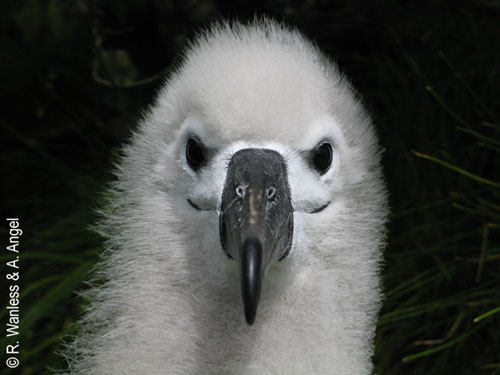The globally Endangered Atlantic Yellow-nosed Abatross Thalassarche chlororhynchos breeds only on the Tristan-Gough islands in the South Atlantic, part of the UK’s Overseas Territory of St Helena, Ascension and Tristan da Cunha. A helicopter-borne aerial photographic survey of the main island of Tristan da Cunha conducted in 2015 has resulted in a breeding estimate of 15 000 pairs (with a range of 9300 to 24 000 pairs), according to a recent report by the UK’s Royal Society for the Preservation of Birds (RSPB).
The aerial survey, the first conducted for the island, is in accord with ACAP’s survey priorities for the species. A previous estimate for the main island, of 16 000 to 30 000 breeding pairs by Mike Richardson, was based on ground observations made from visits to “all quarters of the island on numerous occasions between 1972 and 1974”. He provided estimates for four separate quarters of the island, with larger numbers found farther away from the island’s settlement in the north-west quadrant.
Prior to the 1970s the only published estimate is of 3000 pairs over 1950-52 by Sir Hugh Elliott. Richardson ascribed the increase over two decades to “cessation of egg collecting” on the main island by the Tristan Islanders. The Atlantic Yellow-nosed Albatross is now fully protected throughout the island group.
The following text describing the 2015 survey is taken from the RSPB’s Annual Report for 2016.
“One of the smallest albatross species in the world, the endangered Atlantic yellownosed albatross, only breeds on the islands of Tristan da Cunha in the South Atlantic. Tracking studies show that they forage right across the South Atlantic Ocean, where sadly they are sometimes accidentally caught as bycatch in fisheries. The Albatross Task Force, which the RSPB leads on behalf of BirdLife International, is working with fishermen [sic] to reduce albatross bycatch in this area. Monitoring the success of these efforts requires robust population estimates of the breeding colonies. Historically, the main island of Tristan da Cunha has been the species’ stronghold but the only estimate of its population (16,000- 30,000 breeding pairs) dates from 1974, and was based on general impressions only. In partnership with the Tristan da Cunha Conservation Department and the Percy FitzPatrick Institute of African Ornithology, the RSPB conducted a survey by helicopter in September 2015. By merging more than 600 photographic images, and examining areas of suitable habitat, we estimate that the current population of Tristan da Cunha is around 15,000 pairs (9,300–24,000 pairs). This estimate is being complemented by an updated population estimate from Gough Island, where the previous estimate of 5,100 pairs dates from 2001. Robust population estimates help us to understand the population trend of this globally- threatened species, enabling us to monitor the effectiveness of our actions to reduce bycatch of these beautiful birds at sea.”

Atlantic Yellow-nosed Albatross chick, photograph by Andrea Angel and Ross Wanless
Selected Literature:
Cuthbert, R.J., Ryan, P.G., Cooper, J. & Hilton, G. 2003. Demography and population trends of the Atlantic Yellow-nosed Albatross Thalassarche chlororhynchos. Condor 105: 439-452.
Elliott, H.F.I. 1957. A contribution to the ornithology of the Tristan da Cunha group. Ibis 99: 545-586.
Hayhow, D.B., Bond, A.L., Douse, A., Eaton, M.A., Frost, T., Grice, P.V., Hall, C., Harris, S.J., Havery, S., Hearn, R.D., Noble, D.G., Oppel, S., Williams, J., Win, I. & Wotton, S. 2017. The State of the UK’s Birds 2016. Sandy: Royal Society for the Preservation of Birds. 46 pp.
Richardson, M.E. 1984. Aspects of the ornithology of the Tristan da Cunha group and Gough Island, 1972-1974. Marine Ornithology 12: 123-201.
[Tristan da Cunha] 2006. The Conservation of Native Organisms and Natural Habitats (Tristan da Cunha) Ordinance 2006. The St. Helena Gazette Extraordinary Vol. XLIV, No. 13.
John Cooper, ACAP Information Officer, 13 April 2017

 English
English  Français
Français  Español
Español